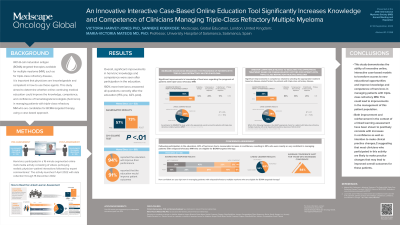Treatment of Relapsed/Refractory Myeloma
Poster Session 2
P-271: Online CME improves clinical decision-making in the management of patients with relapsed/refractory multiple myeloma
Thursday, September 28, 2023
12:30 PM - 1:30 PM EEST


Victoria Harvey-Jones, PhD
Clinical Strategist
WebMD/Medscape Oncology Global, United States
Introduction: Managing relapsed/refractory multiple myeloma (R/R MM) is complex for hematologists/oncologists (hem/oncs), with many treatment options available with varying adverse event profiles. We assessed whether an online, virtual patient simulation (VPS) activity could improve the performance of hem/oncs in ordering appropriate tests, treating R/R MM with available therapies, and managing ocular toxicity associated with a MM treatment.
Methods: This CME-certified VPS consisted of 2 patient cases presented in a platform that allowed physicians to assess the patients and complete open-field entries, choosing from an extensive database of diagnostic and treatment options reflecting the scope and depth of actual practice. After each decision, learners received clinical guidance (CG) based on current evidence and faculty recommendations. Clinical decisions were compared pre- and post-CG using a 2-tailed paired t-test to determine P values (P <.05 is significant). Rationales for clinical decisions were collected in real time. Data were collected between March 2022 and September 2022 and reported here as % relative improvement, P value.
Results: Case 1 (n=286 hem/oncs)
70-yr-old man with a history of MM who has received multiple lines of therapy and requires further treatment. Significant changes observed for:
• Ordering appropriate tests to evaluate the patient (UIFE, 12%, P<.01; LDH, 10%, P<.01; serum Ig, 16%, P<.01; serum IFE, 10%, P<.01; serum FLC, 13%, P<.01; renal function, 13%, P<.01; peripheral blood smear, 15%, P<.01; LFTs, 10%, P<.01; FBC, 8%, P<.05; BM cytogenetics, 8%, P<.05; 24hr urine protein, 10%, P<.01)
• Treating patients with R/R MM therapies (selinexor + dexamethasone, 23%, P<.001; idecabtagene vicleucel, 15%, P<.01; zoledronic acid, 45%, P<.001; order follow-up visits, 13%, P<.01)
Case 2 (n=286 hem/oncs)
76-yr-old man with a history of MM, hypertension, and type 2 diabetes who has completed 3 cycles of belantamab mafodotin (BM) and complained of blurred vision. Significant changes observed for:
• Management of ocular toxicity associated with therapy for R/R MM (discontinue BM, 31%, P<.001; start preservative-free eye drops, 47%, P<.001; order the following: ophthalmology consult, 45%, P<.001; comprehensive eye exam, 9%, P<.05; compliance with eye drop use, 26%, P<.001; avoid contact lens use, 24%, P<.001; advice regarding operating machinery or driving, 28%, P<.001; patient follow-up, 21%, P<.01)
Conclusions: These results demonstrate the success of immersive, online VPS education that engages physicians in a practical learning experience in improving their performance in choosing the optimal therapy for patients with R/R MM, as well as managing treatment-related adverse events.
Methods: This CME-certified VPS consisted of 2 patient cases presented in a platform that allowed physicians to assess the patients and complete open-field entries, choosing from an extensive database of diagnostic and treatment options reflecting the scope and depth of actual practice. After each decision, learners received clinical guidance (CG) based on current evidence and faculty recommendations. Clinical decisions were compared pre- and post-CG using a 2-tailed paired t-test to determine P values (P <.05 is significant). Rationales for clinical decisions were collected in real time. Data were collected between March 2022 and September 2022 and reported here as % relative improvement, P value.
Results: Case 1 (n=286 hem/oncs)
70-yr-old man with a history of MM who has received multiple lines of therapy and requires further treatment. Significant changes observed for:
• Ordering appropriate tests to evaluate the patient (UIFE, 12%, P<.01; LDH, 10%, P<.01; serum Ig, 16%, P<.01; serum IFE, 10%, P<.01; serum FLC, 13%, P<.01; renal function, 13%, P<.01; peripheral blood smear, 15%, P<.01; LFTs, 10%, P<.01; FBC, 8%, P<.05; BM cytogenetics, 8%, P<.05; 24hr urine protein, 10%, P<.01)
• Treating patients with R/R MM therapies (selinexor + dexamethasone, 23%, P<.001; idecabtagene vicleucel, 15%, P<.01; zoledronic acid, 45%, P<.001; order follow-up visits, 13%, P<.01)
Case 2 (n=286 hem/oncs)
76-yr-old man with a history of MM, hypertension, and type 2 diabetes who has completed 3 cycles of belantamab mafodotin (BM) and complained of blurred vision. Significant changes observed for:
• Management of ocular toxicity associated with therapy for R/R MM (discontinue BM, 31%, P<.001; start preservative-free eye drops, 47%, P<.001; order the following: ophthalmology consult, 45%, P<.001; comprehensive eye exam, 9%, P<.05; compliance with eye drop use, 26%, P<.001; avoid contact lens use, 24%, P<.001; advice regarding operating machinery or driving, 28%, P<.001; patient follow-up, 21%, P<.01)
Conclusions: These results demonstrate the success of immersive, online VPS education that engages physicians in a practical learning experience in improving their performance in choosing the optimal therapy for patients with R/R MM, as well as managing treatment-related adverse events.
